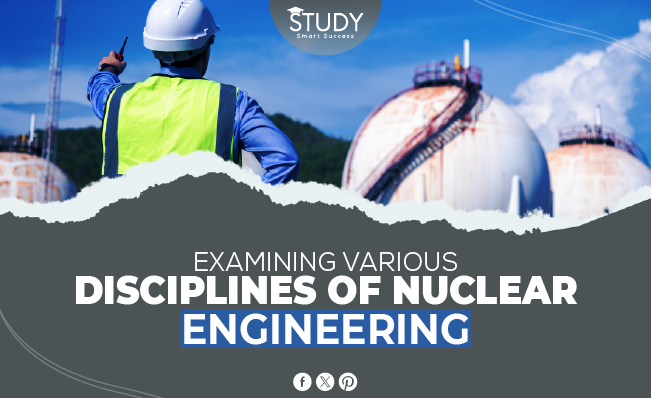Introduction
Nuclear engineering is exciting because it uses physics, chemistry, and engineering to harness atom power. Comprehending nuclear engineering’s disciplines is essential to understanding its complexity and promise, whether you’re an engineering student, science and technology researcher, or atomic energy enthusiast. This blog article will cover nuclear engineering, from power generation to medicine. We’ll discuss major disciplines, their practical applications, and the future of this interesting profession.
What is Nuclear Engineering?
Nuclear engineering is a discipline that investigates the potential applications of atomic processes. This includes building nuclear power plants and using atomic technology in study, medicine, and business. This is a very interdisciplinary field that needs people who know about everything from thermal-hydraulics to nuclear safety. Read more details about what is nuclear engineering?
Nuclear Power Generation
How Nuclear Reactors Work
Nuclear plants are the most important part of making nuclear power. These gadgets start and manage a long-lasting atomic chain reaction to create power. Nuclear reactors are a cleaner way to get energy because they don’t release greenhouse gases like fossil fuel plants. Read blog on how to become a nuclear engineer?
Types of Nuclear Reactors
Different kinds of nuclear reactors have pros and cons. PWRs, BWRs, and Fast Breeder Reactors are the most frequent varieties. Anyone interested in atomic engineering must understand these reactor types.
Safety Measures in Nuclear Plants
When making nuclear power, safety is the most important thing. Some safety precautions are included in modern reactors to either prevent accidents or mitigate their impact if they do occur. Some of these are backup cooling systems, protection buildings, and ways to shut down the plant in an emergency.
Radiation Protection
Understanding Radiation
Radiation safety is an important part of nuclear engineering. It means knowing the different kinds of radiation, where they come from, and how they hurt people and the world. Engineers in this area aim to keep people’s radiation exposure safe.
Protective Measures
Different methods safeguard people from dangerous radiation. Lead shielding and radioactive material management and disposal practices are examples. Monitoring and detecting radiation levels with specialist equipment is part of radiation protection.
Regulatory Standards
Stringent rules are set by groups like the International Atomic Energy Agency (IAEA) and the Nuclear Regulatory Commission (NRC) for this discipline. These rules make sure that nuclear actions are done safely and responsibly.
Nuclear Materials
Types of Nuclear Materials
Nuclear materials engineering studies how materials used in atomic applications work and their qualities. This includes fuels like uranium and plutonium and building materials that can withstand the harsh conditions inside a reactor.
Fuel Cycles
The whole process of making nuclear fuel is called the nuclear fuel cycle. It includes mining and milling, enrichment, manufacturing, and dumping. There are new technical problems and chances to develop new ideas at each cycle stage.
Waste Management
Taking care of nuclear garbage is one of the biggest problems in the field. Engineers are working on new, safer ways to store, move, and eliminate nuclear waste. These include long-term options like rock sites.
Thermal-Hydraulics
Heat Transfer Mechanisms
Thermal hydraulics is the study of how heat moves and how fluids move through nuclear systems. Effective heat movement is needed for reactors to work well and keep them from getting too hot.
Coolant Systems
Coolant systems are important for moving heat from the reactor’s core to a steam generator or a compressor. Coolants like water, heavy water, and liquid metals are used in different reactors.
Accident Analysis
In this field of engineering, accident analysis is also important. To do this, engineers simulate different situations to see how a reactor would respond to them. This helps engineers make systems that can handle situations and keep them from failing terribly.
Nuclear Medicine
Diagnostic Techniques
Nuclear medicine is an interesting way that nuclear engineering is used in medicine. Radioactive chemicals are used for screening and treatment. Positron Emission Tomography (PET) and Single Photon Emission Computed Tomography (SPECT) can make very clear pictures of the inside of the body.
Therapeutic Applications
In addition to being used for diagnosis, nuclear medicine can also be used for treatment. Radioisotopes treat diseases like cancer by finding and killing cancerous cells. Radiotherapy, this type of treatment, has become an important part of modern medicine.
Safety in Medical Use
In nuclear medicine, safety is very crucial to prevent excessive radiation exposure to patients and medical staff. Engineers provide guidelines and instruments to guarantee nuclear resources’ proper and efficient use.
Reactor Physics
Neutron Behavior
Neutrons and their behavior in a nuclear reactor are studied in reactor physics. To control the chain reaction and keep the reactor running smoothly and efficiently, you need to know how neutrons communicate with each other.
Reactor Core Design
You must know a lot about reactor physics to build the reactor’s core. Engineers must consider control rod placement, moderator materials, and fuel arrangement for optimal performance and safety.
Computational Models
Computer models are a big part of modern reactor physics because they can demonstrate how reactors work. These models help engineers guess how a reactor will work in various situations so they can make smart choices about how to build and run it.
Nuclear Regulatory Compliance
Regulatory Framework
Following the rules set by regulators is an important part of nuclear engineering. The regulatory framework comprises standards and regulations that guarantee the secure and safe use of nuclear technology.
Licensing Process
The licensing process for nuclear power plants is very strict and has many levels of review and approval. Engineers must work closely with the groups that set the rules to ensure all project parts meet the standards.
Continuous Monitoring
To stay in line with legal standards, there must be constant tracking. This includes regularly checking, auditing, and reporting to ensure all actions are safe and follow the law.
Nuclear Research and Development
Innovations in Reactor Design
The main way nuclear engineering is improving is through research and development. New types of reactors, like Small Modular Reactors (SMRs) and Generation IV reactors, offer to make nuclear power safer, more efficient, and last longer.
Advanced Materials
Another important area of study is the creation of new materials. New materials with superior qualities can enhance the functionality and longevity of nuclear systems, thereby reducing the frequency of maintenance and replacement.
Future Prospects
Fusion energy and improved nuclear power systems for space travel are just a few of the interesting things that could happen in the future of nuclear engineering. More research and development (R&D) will lead to the next big ideas in this area.
Conclusion
Nuclear engineering is diverse and provides much potential for innovation and growth. Nuclear engineering shapes technology and society from power generation to medicine. Understanding these fields may help engineering students, researchers, and enthusiasts get fresh perspectives and ideas. what can you do with a nuclear engineering degree?
Consider taking specialized classes, visiting industry conferences, or joining professional organizations to learn about nuclear engineering. Nuclear technology has a bright future and many methods to advance it.
Staying educated and involved may help society benefit from nuclear technology.


